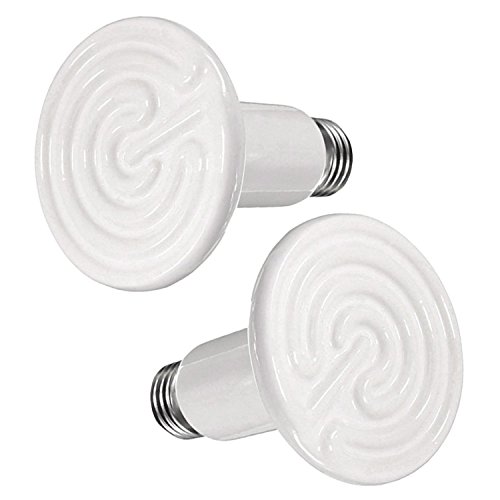One of the main differences between reptiles and conventional pets is that they are cold-blooded animals. This means they cannot regulate their body temperature as their body temperature usually fluctuates with the environment.
You already know that bearded dragons are cold blooded and need external heat source to function properly? Yes, your bearded dragon needs heat to digest food and move about. However, during winter or in cases of power shortage, how do you keep the tank warm? This exclusive tips in “6 Ways To Make Bearded Dragon Tank Hotter” is a must read.
A bearded dragon is not an exception, and they need a nice and warm environment to stay active and digest food. This shows the importance of heat and light in a bearded dragon’s tank. If your dragon stays in a cold enclosure for too long, it will not be active and cannot hunt or digest food.
In this article, we will highlight why your bearded dragon’s enclosure can be too cold, what can happen when this occurs, and ways to make the tank hotter.
Contents
- Signs That Your Bearded Dragon Is Too Cold
- 5 Ways To Check That Your Bearded Dragon Is Cold
- 6 Ways To Make Bearded Dragon Tank Hotter
- Put A Towel Around The Tank To Keep The Current Temperature More Stable
- Increasing Bulb Wattage Or Use Devices for Heating
- Make Sure To Get Accurate Temperature Readings
- Reduce The Distance Between The Light And Your Dragon
- Change The Substrate To Be Less Heat-Absorbing
- Reduce Heat Loss From The Tank
- Trying To Make The Room Where The Bearded Dragon’s Tank Is Hotter
- What Happens If Temperature in Bearded Dragon Tank Is Too Cold
- 6 Causes Of Low Temperature In Bearded Dragon Tank
- Last Sentences
Signs That Your Bearded Dragon Is Too Cold
65°F (18°C) is the lowest temp that your bearded dragon can survive safely. Therefore, always pay attention to the temperature on the thermometer. Besides that, It is important to understand the signs of a cold bearded dragon. Some of the signs that bearded dragons can give when cold are stated below.
- Slow digestion
- Sleeping more
- Loss of appetite
- Your dragon is hiding in the shade
- Slow movement
- Your bearded dragon is drowsy
- Your dragon is not pooping
5 Ways To Check That Your Bearded Dragon Is Cold
In addition to checking the thermometer, there are several ways that you can confirm that your beardies is cold. Some of the ways to check are stated below.
- Feel
- Behavior
- Immobile
- Unresponsive
- Colour
Feel
A simple way that you can determine whether your dragon is cold or not is by touching it. Your bearded dragon temperature is too low if it is cold when you touch it. Generally, beardies spend most of their time looking for a place to bask under, and there is a problem with its heat source if it is cold to touch.
Behavior
Bearded dragons usually look for a heating source to keep warm whenever they feel cold. This means they display basking behaviors to help them soak as much heat as possible. However, you can determine that your bearded dragon is cold if it turns into a scaly pancake.
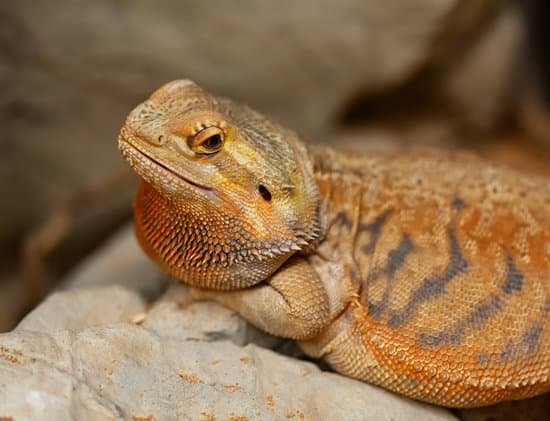
Immobile
When cold for a long time, a bearded dragon can stay completely still and will not move at all. This means it does not have any energy, and there is not enough heat for its metabolism. However, your bearded dragons will still be aware of the environment but are just unwilling to move.
Unresponsive
Bearded dragons are usually unresponsive when they are too cold. You will notice gaps between their breaths and will have shallow breaths. When this happens, you will need to take your pet to the vet immediately for diagnosis and for treatment.
Color
You can also use the color of your bearded dragon to determine whether it is cold or not. When cold, bearded dragon color usually becomes darker to help absorb more heat. It is common for bearded dragon colors to darken early in the morning or at random times, indicating that they are cold.
Note: bearded dragons can change their color for several reasons, and you should try to investigate further before you decide that your dragon is cold.
6 Ways To Make Bearded Dragon Tank Hotter
Some of the ways that you can use to make bearded dragon tank hotter are stated below:
- Put a towel around the tank to keep the current temperature more stable
- Increasing bulb wattage or use devices for heating
- Make sure to get accurate temperature readings
- Reduce the distance between the light and your dragon
- Change the substrate to be less heat-absorbing
- Reduce heat loss from the tank
- Trying to make the room where the bearded dragon’s tank is hotter
Put A Towel Around The Tank To Keep The Current Temperature More Stable
This is a temporary way that owners can keep the bearded dragon tank warm while seeking other solutions. Putting a towel around the tank cannot increase the temperature but will help to keep a stable temperature. This method can work best, especially at night time.
All you need to do is cover all the ventilation holes around the tank. You can also use a towel to wrap your beardies to keep them warm through the night.
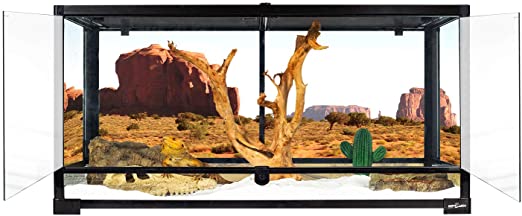
Increasing Bulb Wattage Or Use Devices for Heating
A common way to make a bearded dragon tank hotter is by increasing the bulb wattage. It is recommended that you place the basking bulb close to a UVB light to help ensure your dragon gets UVB while basking.
Note: the type of wattage bulb that you will use for your bearded dragon tank will depend on the room temperature, bulb type, and tank size.
For instance, you should avoid energy-saving bulbs if the room and your dragon tank get too cold because they won’t produce enough heat. However, a 50-60 watt halogen flood lamp can be used to heat a 40-gallon breeder tank.
You will need a 100-watt bulb when using reptile basking bulbs to heat your dragon tank. Another option is mercury vapor bulbs, but it is not recommended for tanks smaller than 40 gallons as they get very hot.
It is best to go for a bright white light bulb because the light is not too bright for your beardies. You can opt for a ceramic heat-emitting bulb if the nighttime temperature in your pet’s tank drops below 65oF. Use a low-wattage ceramic heat-emitting bulb (20-40 watts) if the tank temperature drops slightly.
This will help to ensure the tank temperature does not get hot dramatically.
Some of the popular heaters suitable for bearded dragons are:
- Ceramic Heat Emitter Bulb
- Zoo Med Reptile Lamp Stand
- Zoo Med Labs 25W Nano Ceramic Heat Emitter
- Lamp for Reptile and Amphibian Use
Last update on 2022-12-30 / Affiliate links / Images from Amazon Product Advertising API
Make Sure To Get Accurate Temperature Readings
A common issue faced by owners when deciding the correct bulb is the temperature readings. Apart from getting the correct temperatures, it is important to know how to get an accurate temperature reading.
It can be hard to decide the lamps to use if you are using a stick-on thermometer. This is because they can give inaccurate readings. However, you can get a more accurate reading by placing a digital thermometer close to the basking spot.
All you need is a probe that you can place on the basking spot and then wait for around an hour to get the reading. Another thing to use is a handheld infrared thermometer to help get accurate readings. You can just hold the thermometer about 1.5-2 inches from the basking spot to get the readings.
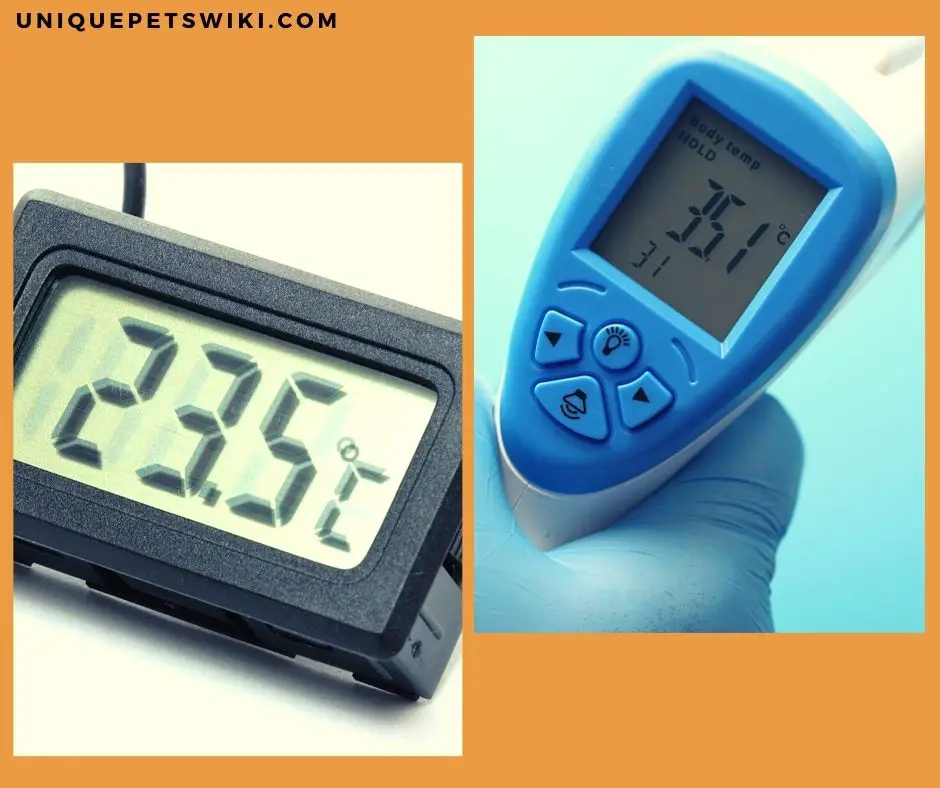
Reduce The Distance Between The Light And Your Dragon
Bearded dragons are active climbers and prefer to climb on a branch, hammock, or any high structure to bask. They enjoy flattening their body to help get as much heat as possible. When using a heightened basking spot, the distance between your dragon and the light will decrease and help them get more heat.
You can also use rocks or DIY boxes as a basking platform for your beardies.
Change The Substrate To Be Less Heat-Absorbing
A top hack to help increase the temperature in your bearded enclosure is by using a substrate that absorbs less heat. Instead of using sand and rubber shelf liner as substrates, you can opt for reptile carpet, newspaper or paper towels, or ceramic tiles.
Reduce Heat Loss From The Tank
There are situations where your lamp is giving the right amount of heat, but it is hard to maintain the temperature in your pet’s enclosure. This can indicate that you are potentially losing the heat out of the enclosure.
This is common when using a glass tank with a mesh top. You can reduce heat loss from this type of tank by covering the mesh area. Another thing that you can do is to buy wood and glass with inbuilt ventilation to help maintain the heat in the enclosure.
Trying To Make The Room Where The Bearded Dragon’s Tank Is Hotter
Generally, you will have difficulty getting the required temperature in a bearded dragon enclosure if the room is too cold. This is why it is important to make the room warmer to help heat the tank. There are several ways to heat a room, such as using radiators, central heating, etc.
All you need is to ensure that the room is around 65-70F to help keep your beardies tank warm both in the day and night.
What Happens If Temperature in Bearded Dragon Tank Is Too Cold
Any temperature lower than 65°F (18°C) is considered unsafe for your bearded dragon. Bearded dragon behavior and activities like movement, bathing, food digestion, and so on will be affected if it stays in a cold enclosure for too long. Some of the things that can be unhappy for your bearded dragons will be discussed in the section.
What Is Ideal Temperature For Bearded Dragon
We would like to talk about the ideal temperature for bearded dragons before discussing the side effects of cold to bearded dragons.
Bearded dragons are cold-blooded reptiles and will need a proper temperature to stay happy and healthy. However, the temperature range needed by bearded dragons usually differs from baby to adult.
Baby bearded dragons usually need a temperature range between 95-110oF in the basking area and 80-90oF in the cool part. However, juvenile bearded dragons require a temperature range between 95-100oF in the basking area and 80-90oF in the cool area.
Adult bearded dragons need a temperature range around 90-93oF in the basking area and 80-90oF in the cool area.
Note: these temperature ranges are daytime temperatures.
Bearded dragon requires a lower temperature at night than in the day. The temperature in their enclosure at night should be between 72-80oF, and you don’t need to turn on bright lights to avoid disturbing their sleeping pattern.
Health Problem When Temperature in Bearded Dragon Tank Is Too Cold
Here are some of the health problems associated with bearded dragons when the tank is too cold.
Digestion Issues
Bearded dragons are cold-blooded animals and need heat for the digestion and absorption of nutrients in their body. Without heat, your bearded dragon will not be able to digest food. This can then affect their overall health as undigested food will be in their system and even rot.
Undigested food can be fatal and even kill your bearded dragon if not addressed. You can ensure this does not happen to your beardies by keeping them in a tank with an ideal temperature.
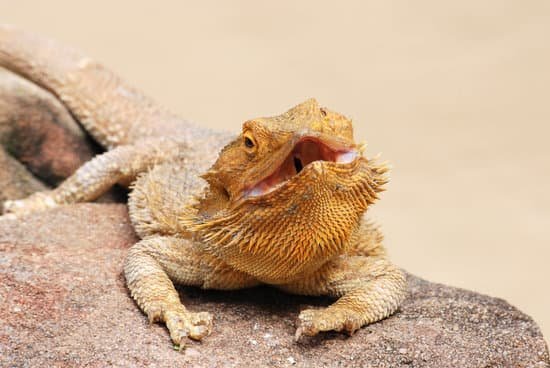
Slow Movement
Bearded dragons are usually lethargic if they are kept in a cold habitat. This is because they will lose their appetite and lead to body weakness since they don’t have enough nutrients. They can even stay in a location and not respond to touch or food.
Respiratory Infection
Bearded dragons can also develop respiratory infections if their tank is cold. This is because high temperatures help to lower the humidity in their enclosure. Bearded dragons can even develop other health issues or even die when cold.
6 Causes Of Low Temperature In Bearded Dragon Tank
Now that you can identify when your bearded dragon is cold, the next thing is to determine what can cause your bearded dragon to be cold. Some things that can cause the low temperature in a bearded dragon’s enclosure are stated below.
Bulb Not Strong Enough And Tank Too Big
The first thing to help determine whether your bearded dragon tank is too cold is by checking the heating bulb. The heating bulb is usually measured in watts, and there are several heating bulbs ranging from 50-100 watts available.
Your bearded dragon enclosure can be cold if you use a heating bulb with a power output that is not enough to create around 100-110oF at the basking spot. Even using the biggest bulb may not warm your bearded dragon enclosure if you place it in a very high place.
This shows the importance of height, and it is recommended that your basking light is about 12 inches from the basking spot to get the required warmness.
Keeping your bearded dragon in a large tank can also cause temperature imbalance. This is because the temperature at the basking spot can be at the optimal range, but that at the cool end will be too cold for your bearded dragon.
A great way to keep a big tank warm is by placing the heat source in the middle of the vivarium. You can also place a ceramic heat emitter at the cool side with a separate thermostat for maintaining the temperature.
You Don’t Use A High Range Thermostat
When compared with other temperate lizards, a beardies enclosure needs to be hot. Generally, you cannot get a high temperature using a normal range thermostat. Furthermore, they will start cutting the light out or dimming it before your dragon can get warm.
This is why it is preferred to go for a high-range thermostat to help keep their enclosure warm.
Too Much Ventilation At The Tank
It is quite hard to get the required temperature for your bearded dragon enclosure if there is too much ventilation. You will have a problem keeping the temperature in a bearded dragon enclosure if you use an enclosure with mesh over its top.
This is because the mesh screens on the top are poor insulators, and hot air from the tank can escape from there. Therefore, you will need to compensate for the heat loss from the tank by increasing the bulb size or covering the mesh with heat-resistant material.
Note: ensure you use a heat-resistant material that is compatible with hot lamps to avoid fire situations.
Substrate Absorbing Most Of The Heat From The Basking Lamp
Another way to lose heat in your bearded dragon enclosure is using a substrate that absorbs most of the heat. These substrates like sand usually absorb most of the heat from the basking lamp and do not release it back to the enclosure readily, which can make the tank colder.
This is more common in new sand as it will take about 1-2 days to warm it up properly.
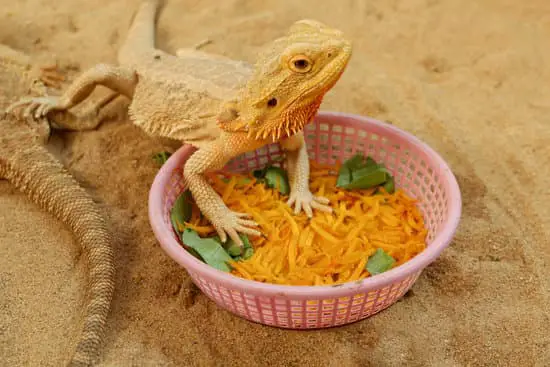
The Room Where The Bearded Dragon’s Tank Is Too Cold
There are times when you can provide all the necessary accessories for your beardies, and you cannot get the temperature up. This can be because the room that you house the tank in is too cold. You will then need to find a way to make the room warmer to help in heating the tank.
Maybe Inaccurate Thermometers
There are situations when the temperature is right, but you are taking the thermometer reading incorrectly. For instance, you may be getting readings that the temperature is 70oF while it can be 100oF. You should go for thermometers you can easily read and check out ways to use a thermometer.
Last Sentences
Bearded dragons are cold-blooded lizards and can’t generate their body heat. This means they need an external heat source to keep them active and for their bodily functions. Furthermore, beardies can develop health problems if kept in extreme cold conditions and can even die.
Making a bearded dragon tank hotter is quite easy if you follow the steps listed above. However, you should seek veterinary advice once you get to the point that you cannot warm your cold beardies no matter the steps you try.

